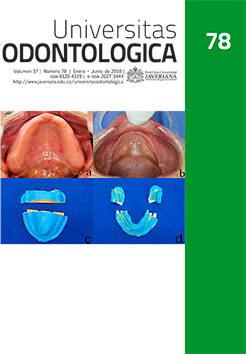Abstract
Background: Soft-tissue treatment techniques for alveolar ridge augmentation include connective tissue grafts, with or without epithelial collar, and roll techniques. Sometimes, there are postoperative complications. Purpose: To describe a case for a female patient who underwent an alveolar ridge augmentation and developed an exostosis. Case description: A 35-year-old female patient underwent an alveolar ridge augmentation procedure through a pocket technique in the upper right central incisor. A connective tissue graft without epithelial collar from the palate was transplanted and covered with the flap. Seven years later the patient returned with an exostosis in the buccal area of the treated tooth that affected her aesthetically. An osteoplasty was performed and a bone biopsy was taken, whose histopathological analysis showed a bone-compatible tissue. Conclusion: Exostosis is an unusual postoperative complication in cases of alveolar ridge augmentation that can be successfully treated. More research is necessary about such complications.
Gyovai L, Manzione L. Oral medicine. Patient evaluation and management. 1st edition. Baltimore, MD: Williams and Wilkins; 1980.
Suzuki M, Sakai T. A familial study of the torus palatinus and torus mandibularis. Am J Phys Anthropol. 1960; 18: 263-72.
Shafer WG, Hine MK, Levy BM. Tratado de patología bucal. 4ta. ed. México: Interamericana; 2000.
Antonides DZ, Belazi M, Papanayiotou P. Concurrence of torus palatinus with palatal and buccal exostoses: case and review of the literature. Oral Surg Oral Med Oral Pathol. 1998; 85: 552-7.
Nolte A, Schirren CG. Torus mandibularis. Hautarzt. 1997; 48(6): 414-6.
Pynn B, Kurys-Kos NS, Walker DA, Mayhall JT. Tori mandibularis. A case report and review of the literature. J Can Dent Assoc. 1995; 61: 1057-66.
Seah YH. Torus palatinus and torus mandibularis. A review of the literature. Aust Dent J. 1995; 40: 318-21.
Horning GM, Cohen ME, Neils TA. Buccal alveolar exostoses: prevalence, characteristics, and evidence for buttressing bone formation. J Periodontol. 2000; 71(6): 1032-42.
Shaffer W, Hine M, Levy B, Tomich C. Tratado de patología bucal. 4ª edición. México: Interamericana; 1988.
Gorlin T, Golman R. Oral pathology. 1st edition. Madrid: Salvat; 1975.
Wood NK, Goaz PW. Differential diagnosis of oral lesions. St. Louis, MO: Mosby; 1991.
Gargiulo A, Arrocha R. Histo-clinical evaluation of free gingival grafts. Periodontics. 1967; 5(6): 285-91.
Ouhayoun JP, Sawaf MH, Goffaux JC, Etierme D, Forest N. Re-epithelialization of a palatal connective tissue graft transplanted in a non-keratinized alveolar mucosa: A histological and biochemical study in humans. J Period Res. 1988; 23(2): 127-33.
Abrams L. Augmentation of the deformed residual edentulous ridge for fixed prosthesis. Compend Contin Educ Gen Dent. 1980; 1(3): 205-13.
Scharf D, Tarnow D. Modified roll technique for localized alveolar ridge augmentation. Int J Periodontics Restorative Dent. 1992; 12(5): 415-25.
Barone R, Clauser C, Prato GP. Localized soft tissue ridge augmentation at phase 2 implant surgery: A case report. Int J Periodontics Restorative Dent. 1999; 19(2): 141-5.
Gasparini DO. Double-fold connective tissue pedicle graft: A novel approach for ridge augmentation. Int J Periodontics Restorative Dent. 2004; 24(3): 280-7.
Burton L, Lawrence JC. The subepithelial connective tissue graft. A new approach to the enhancement of anterior cosmetics. Int J Periodontics Restorative Dent. 1982; 2(2): 22-33.
Seibert JS. Reconstruction of deformed, partially edentulous ridges, using full thickness onlay grafts. Part I. Technique and wound healing. Compend Contin Educ Dent. 1983; 4(5): 437-53.
Seibert JS. Reconstruction of deformed, partially edentulous ridges, using full thickness onlay grafts. Part II. Prosthetic/periodontal interrelationships. Compend Contin Educ Dent. 1983; 4(6): 549-62.
Seibert JS, Louis JV. Soft tissue ridge augmentation utilizing a combination onlay-interpositional graft procedure: a case report. Int J Periodontics Restorative Dent. 1996; 16(4): 310-21.
Langer B, Calagna L. The subepithelial graft. A new approach to enhancement of anterior cosmetics. Int J Periodontics Restorative Dent. 1982; 2(2): 23-34.
Pack AR, Gaudie WM, Jennings AM. Bony exostosis as a sequela to free gingival grafting: Two case reports. J Periodontol. 1991; 62(4): 269-71.
Otero-Cagide FJ, Singer DL, Hoover Jay. Exostosis associated with autogenous gingival grafts: A report of 9 cases. J Periodontol. 1996; 67(6): 611-6.
Echeverria JJ, Montero M, Abad D, Gay C. Exostosis following a free gingival graft. J Clin Periodontol. 2002; 29(5): 474-7.
Pasquinelli KL. The histology of new attachment utilizing a thick autogenous soft tissue graft in an area of deep recession: A Case report. Int J Periodontics Restorative Dent. 1995; 3: 98-100.
This journal is registered under a Creative Commons Attribution 4.0 International Public License. Thus, this work may be reproduced, distributed, and publicly shared in digital format, as long as the names of the authors and Pontificia Universidad Javeriana are acknowledged. Others are allowed to quote, adapt, transform, auto-archive, republish, and create based on this material, for any purpose (even commercial ones), provided the authorship is duly acknowledged, a link to the original work is provided, and it is specified if changes have been made. Pontificia Universidad Javeriana does not hold the rights of published works and the authors are solely responsible for the contents of their works; they keep the moral, intellectual, privacy, and publicity rights.
Approving the intervention of the work (review, copy-editing, translation, layout) and the following outreach, are granted through an use license and not through an assignment of rights. This means the journal and Pontificia Universidad Javeriana cannot be held responsible for any ethical malpractice by the authors. As a consequence of the protection granted by the use license, the journal is not required to publish recantations or modify information already published, unless the errata stems from the editorial management process. Publishing contents in this journal does not generate royalties for contributors.


